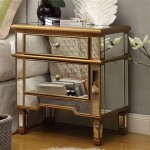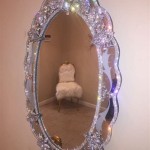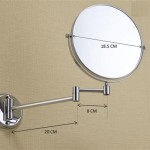How To Remove a Bathroom Mirror From the Wall
Removing a bathroom mirror from the wall can seem like a daunting task, but with the right tools, preparation, and a systematic approach, it can be accomplished safely and effectively. This article provides a comprehensive guide to various methods for removing bathroom mirrors, addressing different mounting techniques and offering solutions for common challenges. Understanding the mirror's installation method is crucial before proceeding, as forcing removal can lead to damage to the mirror, the wall, or both.
Before beginning any removal process, safety should be the primary concern. Eye protection in the form of safety glasses or goggles is essential to prevent fragments of glass or adhesive from entering the eyes. Similarly, wearing work gloves will protect hands from sharp edges and potential irritants. Preparing the surrounding area is also vital; covering the floor with a drop cloth will catch any falling debris and prevent damage to the flooring. Adequate lighting is necessary to clearly see the mirror's mounting system and any potential hazards.
Assessing the mirror's attachment method is the first step in a successful removal. Bathroom mirrors are typically attached to walls using one of several methods: adhesive, clips, screws, or a combination of these. The method used will determine the appropriate removal technique. Careful observation of the mirror's edges and back will usually reveal the attachment mechanism.
Identifying the Mirror's Attachment Method
The most common attachment method for bathroom mirrors involves the use of adhesive. This is particularly prevalent in modern installations where a clean, frameless look is desired. Mirrors affixed with adhesive are directly glued to the wall surface, often utilizing construction adhesive or mirror mastic. To determine if adhesive is the primary attachment method, carefully examine the edges of the mirror. If there are no visible screws or clips, and the mirror appears to be flush against the wall, it is likely attached with adhesive.
Another common method involves the use of metal or plastic clips. These clips are typically positioned around the perimeter of the mirror, holding it in place. They may be visible along the edges, or they may be concealed by the mirror frame. If clips are present, they will need to be removed before attempting to detach the mirror. The design of the clips can vary; some simply snap into place, while others may require screws to be loosened or removed.
Screws are another method used to secure mirrors to walls, often in conjunction with clips or a hanging system. Screws may be visible, especially if the mirror is framed. Sometimes, the screws are hidden behind decorative caps that need to be carefully pried off before the screws can be accessed. Mirrors with a hanging system, similar to pictures, will have screws or hooks mounted on the wall to support the mirror's weight.
Removing Mirrors Attached with Adhesive
Removing a mirror attached with adhesive requires patience and care to minimize damage to the wall. The primary goal is to separate the adhesive bond without shattering the mirror or tearing off the drywall paper. Several tools and techniques can be used to achieve this.
A piano wire or a specialized mirror removal tool can be used to slice through the adhesive. The wire or tool is carefully inserted behind the mirror, near one of the corners, and then slowly worked along the back, cutting through the adhesive. This process may require multiple passes and should be done carefully to avoid applying excessive pressure, which could crack the mirror.
Another technique involves using a heat gun or hair dryer to soften the adhesive. Applying moderate heat to the perimeter of the mirror, especially along the top edge, can help to weaken the adhesive bond. While heating, gently try to pry the mirror away from the wall using a putty knife or a thin pry bar. Be careful not to overheat the adhesive, as this could damage the wall surface or cause the mirror to crack.
If the mirror is large and heavy, it is advisable to use suction cups to provide extra support during the removal process. Suction cups can be attached to the face of the mirror to provide a secure grip, making it easier to handle and prevent it from falling. Having an assistant to help support the mirror during removal is also recommended.
Once the mirror is removed, there will likely be residual adhesive remaining on the wall. This adhesive can be removed using a scraper, putty knife, or adhesive remover. Apply the adhesive remover according to the manufacturer's instructions and allow it to soften the adhesive before scraping it away. Be careful not to damage the wall surface during this process.
Removing Mirrors Attached with Clips or Screws
Removing mirrors attached with clips or screws is generally a simpler process than removing those affixed with adhesive. However, it still requires a careful and methodical approach to avoid damage.
For mirrors attached with clips, start by identifying the type of clips being used. Some clips can be easily snapped open or released by pressing on a lever, while others require a screwdriver to loosen or remove screws. Carefully examine each clip and determine the appropriate method for releasing it. If screws are involved, use the correct size screwdriver to avoid stripping the screw heads. Once all the clips have been released, carefully lift the mirror away from the wall. It is advisable to have an assistant to help support the mirror, especially if it is large and heavy.
If the mirror is attached with screws, locate all the screws that are holding the mirror in place. These screws may be visible, or they may be hidden behind decorative caps. If caps are present, carefully pry them off using a small flathead screwdriver or a putty knife. Be careful not to damage the caps during this process, as they may be needed to reattach the mirror later. Once the screws are exposed, use the correct size screwdriver to remove them. As the last screw is being removed, support the mirror to prevent it from falling.
Mirrors that are hung using a hanging system similar to pictures will require a slightly different approach. First, identify the mounting hardware on the wall (hooks or screws). Next, carefully lift the mirror upwards and off the hooks or screws. It may be necessary to tilt the mirror slightly to disengage it from the hanging system. Once the mirror is removed, the hooks or screws can be removed from the wall using a screwdriver.
After removing the mirror, inspect the wall for any damage. Fill any screw holes with spackle or drywall compound and allow it to dry completely before sanding it smooth. If the wall has been damaged from adhesive removal, repair it using drywall compound and sand it smooth. Once the repairs are complete, the wall can be primed and painted to match the surrounding area.
Regardless of the removal method, proper disposal of the mirror is important. Large pieces of glass should be wrapped carefully in heavy-duty packaging material, such as cardboard or bubble wrap, and clearly labeled as "fragile" and "glass." Contact local waste management services to determine the proper disposal method for large glass items. Smaller pieces of glass can be disposed of in a sturdy container lined with a heavy-duty plastic bag.

How To Remove A Bathroom Mirror Lowe S

How To Remove A Mirror Glued The Wall Forbes Home

How To Safely And Easily Remove A Large Bathroom Builder Mirror From The Wall Site Title

How To Remove Mirror Off Wallsafely

How To Safely And Easily Remove A Large Bathroom Builder Mirror From The Wall Site Title

How To Remove A Frameless Mirror Like Nervous Grandma

How To Remove A Bathroom Mirror Lowe S

How To Safely And Easily Remove A Large Bathroom Builder Mirror From The Wall Site Title

How To Remove A Wall Mirror Diy Weekend Project Rustic Mirrors Black

2 Step Guide How To Remove A Bathroom Mirror With Clips








